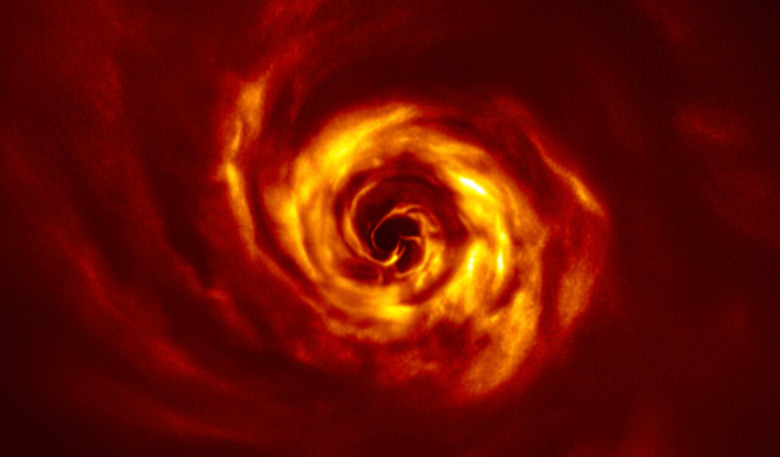A twisted feature spotted in a prominent dust and gas-laden spiral structure could be the first direct evidence of a baby planet coming into existence, say astronomers who have been studying a young star 520 light-years away from Earth.
The telltale signs of a star system being born have been captured by observations made with the European Southern Observatory’s Very Large Telescope (ESO’s VLT) which has produced stunning new images of spiralling dust and gas around AB Aurigae, located in the constellation of Auriga (The Charioteer).
In the decades following the first confirmed detection of an exoplanet, thousands more have been identified and although astronomers know planets are born in dusty discs surrounding young stars, like AB Aurigae, little is known about how they form, says Anthony Boccaletti who led the study from the Observatoire de Paris, PSL University, France.
The currently accepted method by which planets are formed is via the accretion of cold gas and dust in proto-planetary disks, that clump together to form larger and larger objects. Eventually, some of them will grow big enough for their gravity to shape them into spheres, spawning the creation of a planet, dwarf planet or large moon.
The presence in a disk is marked by a spiral, formed when a baby planet has ‘kicked’ the gas as it orbits around its evolving host star, creating “disturbances in the disc in the form of a wave, somewhat like the wake of a boat on a lake,” explains Emmanuel Di Folco of the Astrophysics Laboratory of Bordeaux (LAB), France, who also participated in the study.
Twists then appear when two spirals — one winding inwards of the planet’s orbit, the other expanding outwards – connect. They allow gas and dust from the disc to accrete onto the forming planet and make it grow says co-author Anne Dutrey, also at LAB.
Although telescopes such as the Atacama Large Millimetre/submillimetre Array (ALMA) has become very adept at observing planet-forming disks, astronomers had been unable to take sufficiently sharp and deep images of these young discs to find the twist that marks the spot where a baby planet may be coming to existence.
With the help of the SPHERE instrument on ESO’s VLT in Chile, Boccaletti and his team have now been able spot this revealing feature as a very bright yellow twist region close to the centre of the new AB Aurigae image.
The twist is expected from some theoretical models of planet formation, adds Dutrey and this one lies at about the same distance from the star as Neptune from the Sun.
Soon astronomers should be able to get even more detailed views of planets in the making when ESO finishes construction of its Extremely Large Telescope.
With a whopping 39-metre compared with the 8.2 metre diameter and four movable 1.8 metre diameter Auxiliary Telescopes of the VLT, the optical/near-infrared behemoth observatory should be able to see directly and more precisely how the dynamics of the gas contributes to the formation of planets, Boccaletti concludes.
This research can be found in the Astronomy & Astrophysics journal under the heading; “Possible evidence of ongoing planet formation in AB Aurigae: A showcase of the SPHERE/ALMA synergy.”
If you've enjoyed reading this article, please consider subscribing to ROOM Space Journal to gain immediate and full access to the latest magazine feature articles and receive your own print and/or digital copies of ROOM magazine delivered direct to your door or electronically.











